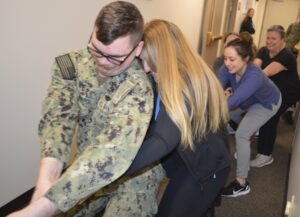
Story by Douglas Stutz
Naval Hospital Bremerton/Navy Medicine Readiness and Training Command Bremerton
Give them a hand.
Or wrist, forearm, elbow.
In return, restorative treatment in support of operational readiness will be hand delivered.
From improved hand-to-eye coordination, enhanced manual dexterity, increased range of motion, and more, Navy Medical Service Corps officers and civil service occupational therapists provide crucial support at military treatment facilities like Naval Hospital Bremerton.
In conjunction with April designated as Occupational Therapy Month, Ms. Teri Nyblom, NHB certified occupational therapist assistant, showcased to her Physical Therapy Department colleagues on how occupational therapy can help those in need to recuperate, recover, and rehabilitate from an injury.
Nyblom tasked her coworkers with a series of upper extremity drills – from shoulder and elbow to wrist and hand – specifically designed to exercise, enlighten and educate them in her chosen field.
“We will have competitive fun, but after each assigned task we will break it down and have a brief discussion and quick analysis of the steps, risks and benefits,” shared Nyblom. “What muscles, joints were used? What were the indications and contraindications of each activity?”
There were individual and team activities which challenged each contestant on performing what seemed like a series of children games, but with a decidedly occupational therapy twist.
Nyblom stressed for each contestant to consider the following during each activity; “What is the normal range of motion and what type of motions – flexion, extension, abduction, adduction – do those muscles make?” “How far into rehabilitation would you want a patient to perform the activity safely?”
One game had individual players step into a roped-off area to try their luck at what appeared to be a game of jacks. “But on a larger scale,” explained Nyblom. “With the timer set at 30 seconds, each player has to keep a balloon from not touching the ground while they try to scoop as many balls into a bucket as possible. Player with the most balls wins.”
Twenty staff members were divided into two even teams, with each member facing their opposite across a straight line. There was a cup in front of each of the ten groupings. Nyblom called out instructions, “head, shoulder, knees, and toes,” directing players to go through the motions, interspersed with her suddenly shouting “cup,” abruptly directing participants to grab the cup as quickly as possible before their opponent.
Players also teamed up for a tug of war contest, getting three minutes to pull their opposing team across the demarcation line.
Dodgeball provided yet another opportunity to have players test their hand-to-eye coordination.
Although occupational therapy and physical therapy are closely aligned – for Fiscal Year 2024, they combined to treat over 14,300 patients – there is a difference.
According to Nyblom, occupational therapy promotes health by enabling individuals to achieve independence and improve their ability to perform meaningful and purposeful daily activities across their lifespan.
“We deal with a lot of repetitive motion injuries and combine teaching and training to help the healing,” Nyblom said. “Healing can be hard.”
Physical therapy primarily focuses on healing a body’s damage and helping a patient’s physical mobility, movement, and ability to function.
Occupational therapists also work with patients who have suffered debilitating medical conditions such as a stroke, traumatic brain injury, spinal cord injury.
The month also hold special significance for command leadership.
“Being an occupational therapist in the Navy has been an incredibly meaningful and diverse journey. I’ve had the privilege of serving on a hospital ship, providing care in a combat hospital in Afghanistan, and working with infants, children, and families in Department of Defense dependent schools in Japan,” shared Capt. Karla Lepore, Navy Medicine Readiness Training Command Bremerton commanding officer and NHB director. “From supporting our retirees and military families to helping our active duty Sailors recover, adapt, and thrive, this role has allowed me to make a real difference at every stage of life. Expanding into a military treatment facility leadership role is an exciting next chapter, and I’m grateful to continue growing the reach and impact of occupational therapy across our military healthcare system.”
Another commonality injury which Nyblom routinely encounters is what she refers to as FOOSH – the occupational therapy abbreviation for ‘fell on outstretched hand’ – with a patient needing help to increase [their] range of motion, improve fine motor skills and bolster nerve regeneration.
Some of the most regular injuries seen by the Occupational Therapy clinic tend to be associated with the wrist, hand and forearm such as lacerated tendon(s) on a finger(s), tendinitis – inflammation – fractures and carpal tunnel syndrome.
“We see a lot of lateral epicondylitis and medial epicondylitis – more commonly known as tennis elbow and golfer’s elbow. Both injuries are caused by overuse,” remarked Nyblom.
Occupational therapists also treat such diagnoses as arthritis, autism, Post-Traumatic Stress Disorder (PTSD), depression, Parkinson’s disease, muscular dystrophy, complex regional pain syndrome, multiple sclerosis, cerebral palsy, neuropathy, microcephaly, amyotrophic lateral sclerosis (ALS), and Huntington’s disease.
There was also trivia – naturally occupational therapy themed – shared.
How many bones are in the adult human body? There’s 206.
How many muscles are in the adult human body? There’s 650. “Although some say up to 840, but they aren’t all skeletal, such as the heart,” Nyblom said.
Helping a patient mend any of those 206 bones which might be broken and assist in any of those 650 muscles which might be torn is why Nyblom and other occupational therapists are recognized in April.
And commemorated for their efforts the rest of the year.